A mix of old and new; stone and glass, side by side. With 18th century stone and brick buildings standing beside modern office buildings, a walk through the streets surrounding Halifax Harbour lets you see the city’s history and its future at the same time.
Halifax is the capital of Nova Scotia and the largest capital in the Maritime provinces. Even though the Halifax area was settled by indigenous Mi’kmaq before being taken over by the Acadian French in the 1600s, it wasn’t until the early 1700s that the British established a town. The British built a citadel on top of a small hill not far from the waterfront. From the top of this hill you can see the water below providing it with a good vantage point to protect the harbour. Eventually the much larger Fort George was built on this strategic spot. Today it is called Halifax Citadel National Historic Site and is operated by Parks Canada. It is open to visitors and is a great place to begin your tour of Historic Halifax.
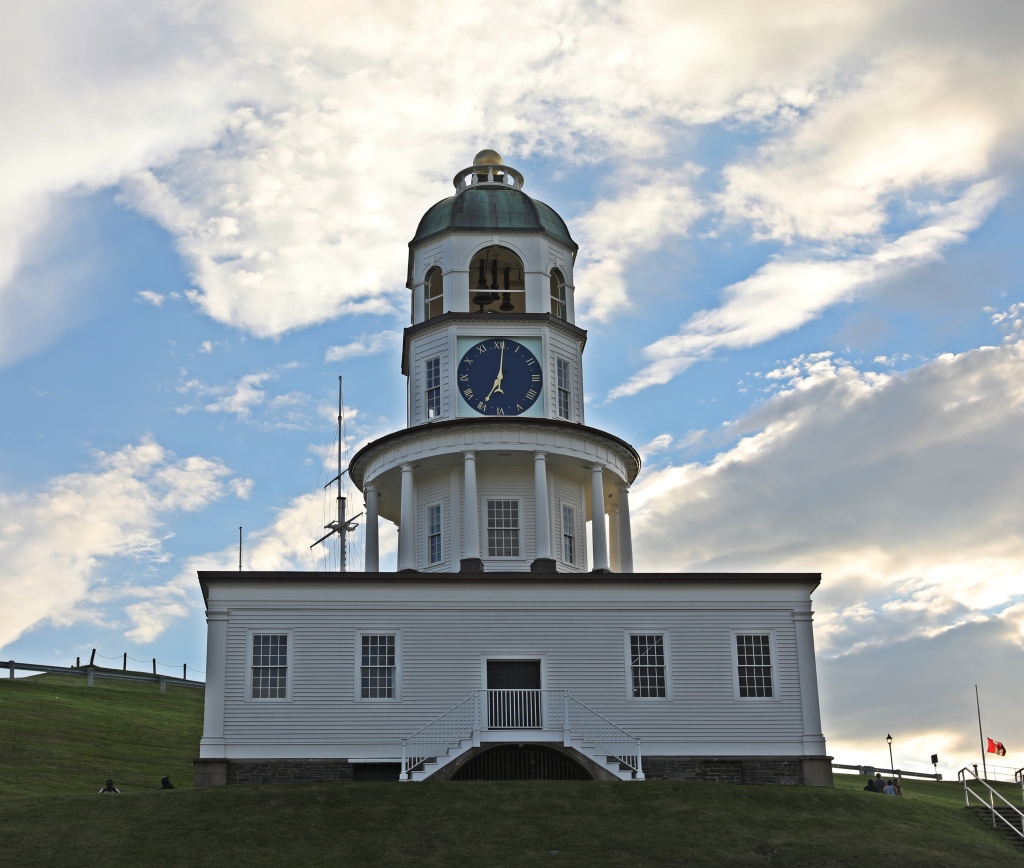
Halifax Citadel National Historic Site, Halifax 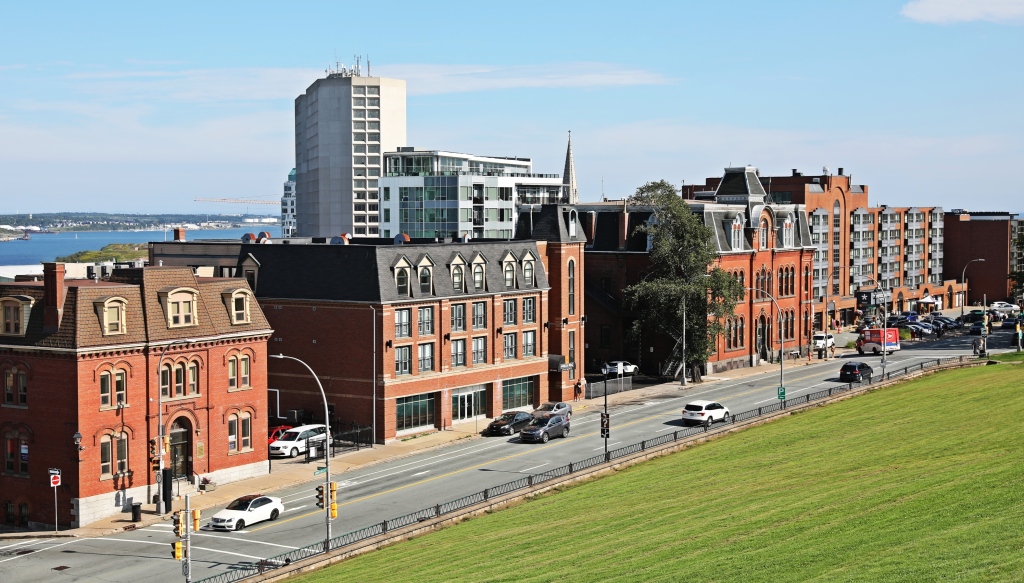
View from Citadel, Halifax 
Looking toward the Citadel, Halifax
In its early history, the village of Halifax filled in the space between Citadel Hill and the harbour. Today 18th and 19th century heritage buildings are intermingled with modern office buildings, but the history of Halifax can still be seen. It’s a great place to spend an afternoon wandering up and down the streets of downtown Halifax admiring the architecture, as you slowly make your way to the waterfront.

Downtown Halifax 
Heritage buildings, Halifax 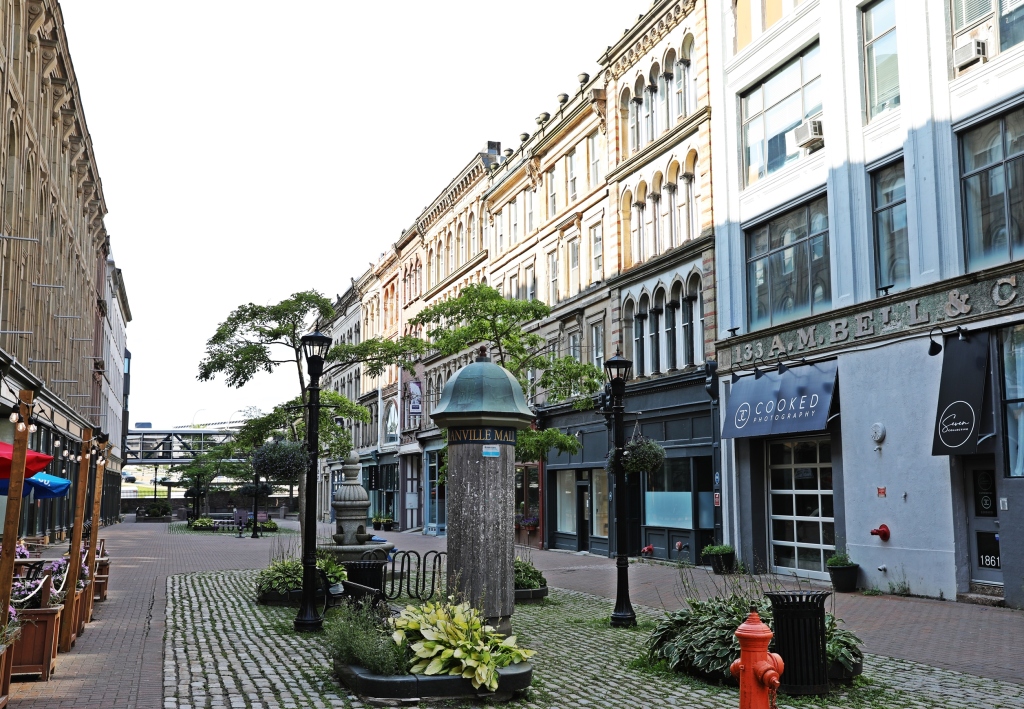
Heritage Buildings, Halifax 
Downtown Halifax
There is a wide range of architectural styles in the churches in the historic district. They range from the delicate spire of St. Mary’s Basilica to the stoic brick front of The Presbyterian Church of St. David. For a more somber site visit the nearby Old Burial Ground. It’s fascinating to walk between gravestones that date as early as 1749. Many important Haligonians in Halifax’s history were buried there. A Haligonian is not a hooligan as it sounds, but is the term for a resident of Halifax.

St Mary’s Cathedral Basilica, Halifax 
The Presbyterian Church of St. David, Halifax 
The Old Burial Ground, Halifax 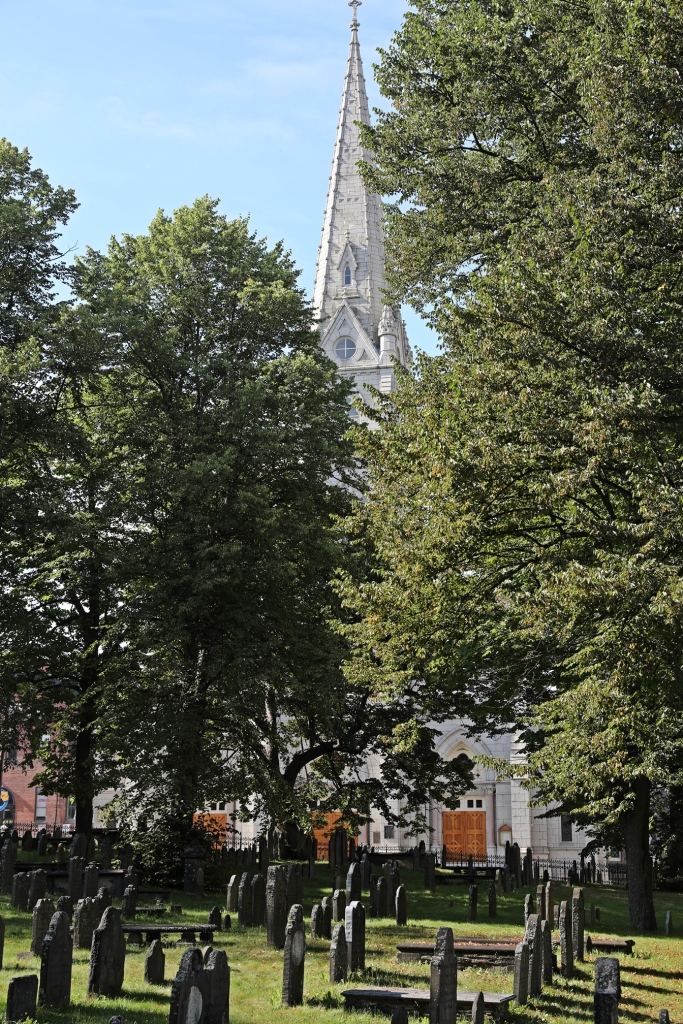
The Old Burial Ground in front of St Mary’s Basilica, Halifax
Closer to the harbour you’ll find centuries old wooden and brick buildings that were once warehouses and shops. Today they are a part of the busy tourist centre and are used as restaurants and craft shops. The area has retained its historic charm though. It’s easy to imagine the boardwalks filled with crates of cargo while merchants and traders made deals in the the old wooden shops.
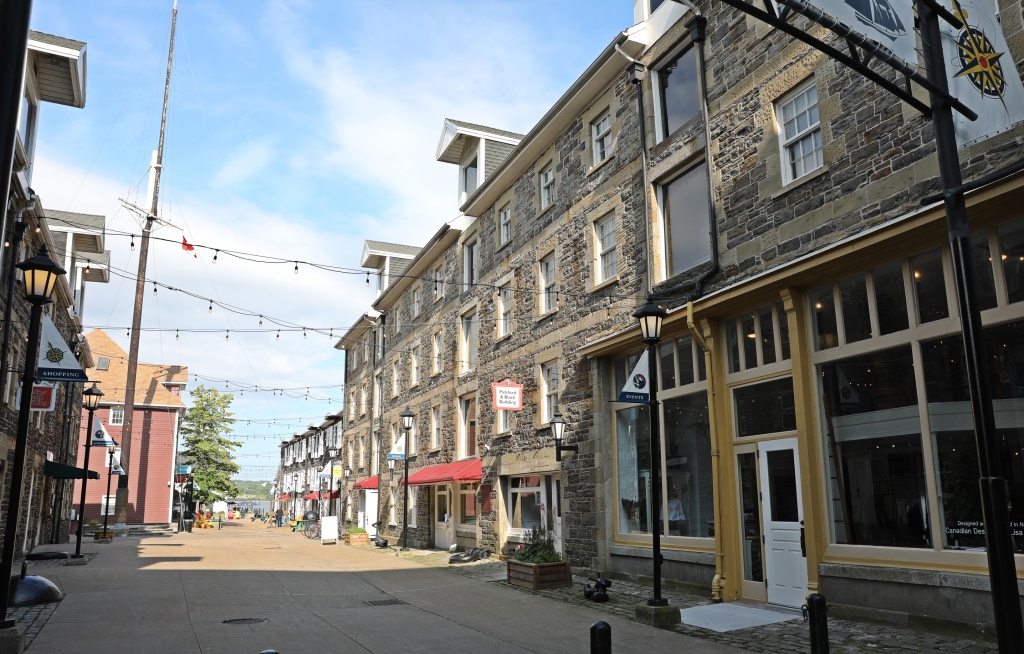
Heritage Buildings, Halifax Harbour 
Heritage Buildings, Halifax Harbour
Follow the boardwalk to the busy waterfront. On one side large cargo ships are docked at the many piers of Halifax Harbour. If you’re lucky you may even see a tall ship. Patios and craft stores line the other side of the boardwalk and provide a lively atmosphere to the waterfront.
On the other side of the inlet is Dartmouth. It used to be a separate city, but is now considered a part of Halifax Regional Municipality. Two suspension bridges connect the two centres. Unfortunately tall smoke stacks spoil the view of the bridges.

Halifax Harbour 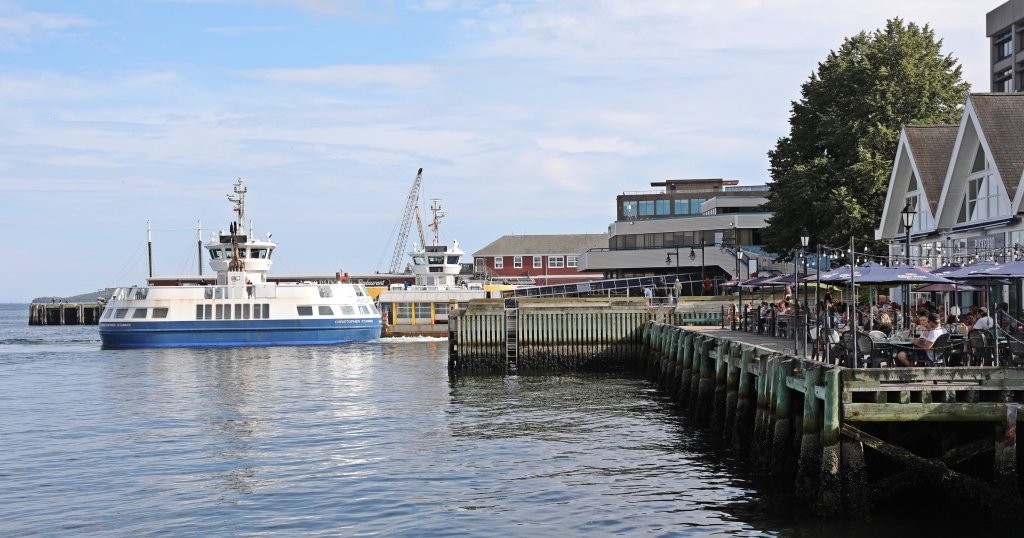
Halifax Harbour 
Halifax Harbour and Angus MacDonald Bridge, Halifax 
Tall Ship, Halifax Harbour
Looking toward the sea from Halifax Harbour is picturesque Georges Island and its pretty lighthouse. The island’s location at the entry point to the harbour was ideal for defending the harbour. The British realized this and built Fort Charlotte on the island. In the 1700s, during the Seven Years’ War, this small island imprisoned an astonishing 1,000 French sailors. Georges Island is now a National Historic Site that you can visit. It is operated by Parks Canada and ferries are available from Halifax Harbour.

Georges Island, Halifax
If you have time it’s worth it to drive south-east of Halifax and follow the Number 7 coastal highway. There are lovely views as the road meanders along the convoluted shoreline. Most traffic takes the Trans-Canada Highway toward Cape Breton, or visits the western end toward Peggy’s Cove, so this scenic drive doesn’t have much traffic.

Liscomb River, Nova Scotia 
Liscomb River, Nova Scotia 
Southern Nova Scotia 
Near Sheet Harbour, Nova Scotia
Coming Next – Captivating Views of Peggy’s Cove
For more pictures from our travels around the world visit Gallery on monkeystale.ca
To read stories from other parts of the world visit Destinations.
If you like what you read please share, with credit, using one of the links below.
The town looks so clean and tidy.
LikeLiked by 1 person
It is very clean as are all of the Martimes. It shows their pride in their cities and towns.
LikeLiked by 1 person
Beautiful photos!
LikeLiked by 1 person
Thank you!
LikeLiked by 1 person
Thanks for this virtual trip to a charming town in Canada. I have heard of Halifax before but have never taken a virtual tour. Thanks for sharing, Maggie
LikeLiked by 1 person
Thanks Arv! Halifax has a great downtown and Harbour area. Glad you came on the tour 😊 Maggie
LikeLiked by 1 person
Great. Thanks once again for the tour, Maggie 🙂
LikeLike
Seems like a hidden gem, since I never would have thought of going there (Nova Scotia makes me think of cold), but really nice architecture.
LikeLiked by 1 person
Well they do have bad storms in the winter but really nice summers. Just wait until you see the rest of Nova Scotia, then you’ll want to visit. 😊 Maggie
LikeLike
Great photos, we stayed in Halifax for a couple of weeks and absolutely loved the history and character of the place, And the people were so very friendly. Lovely town to visit.
LikeLiked by 1 person
Thank you! Halifax is a great city and the people are incredibly friendly in fact all of the Maritime provinces are incredibly friendly. Thans for reading! Maggie
LikeLiked by 1 person
We have been to Halifax many times and still enthralls, especially the harbour area. After missing a chance to sail on the Bluenose in 2005, we managed a sail on a small schooner in Halifax Harbour. Not the same, but good enough. Thanks for sharing. Stay well. Allan
LikeLiked by 1 person
I’ve never been on a boat in the harbour that would be a nice place to sail! Thanks for reading Allan! Maggie
LikeLike
Cool town and love that river!
LikeLiked by 1 person
Thanks Pam! It’s a great Maritime city!
LikeLiked by 1 person
Haligonian is also the term for people from the Halifax over here too, though the two places are very different judging by your text and photographs. The English Halifax isn’t coastal, for a start! The Nova Scotia version looks absolutely charming.
LikeLiked by 1 person
It is very charming. Most places in Canada have UK names based on where it reminded the setlers of in the UK or where they are from, but Halifax was named after a person. It is one of the funnest names for citizens though! Maggie
LikeLiked by 1 person
Those buildings look incredible! I have heard Halifax has some great comedy shows too, like the Halifax Comedy Fest. I am thinking of visiting there when it’s on so I can see it live!
LikeLiked by 1 person
I’ve never been, hopefully they’ll be back next summer.
LikeLiked by 1 person
I hope so too! I certainly love watching past seasons on CBC!
LikeLike
I always thought that Halifax is a beautiful city and your photo’s just proved that! Lovely pictures of the streets and harbour and a great view of the Liscomb River.
LikeLiked by 1 person
Thanks, I’m glad it showed well in the pictures. Halifax is a great city, and we were so impressed with our coastal drive. Thanks for reading!! Maggie
LikeLiked by 1 person
Very interesting read. I was a bit down on the British imprisoning so many sailers over 7 years on such a small island, which can only mean inhuman conditions, but the views of South Halifax were uplifting.
LikeLiked by 1 person
Yes, I’m sure there were many inhumane things done on both sides during those days. The town though has a lovely setting and and a lively atmosphere to put you in a good mood 🙂 Maggie
LikeLike
The heritage buildings are handsome and charming. I couldn’t say the same about the modern glass and steel constructions looming above and behind the old houses. Your photos are wonderful. I’ve enjoyed the read.
LikeLiked by 1 person
No the modern buildings were a bit disappointing especially after the other Old Towns we’ve seen lately. The difference I guess is this is a working downtown, not a tourist site. The harbour views more than made up for it though 🙂 Maggie
LikeLiked by 1 person
Looks like a lovely town. Thanks for the tour.
LikeLiked by 1 person
Sometimes visiting cities can be fun too. 🙂
LikeLiked by 1 person
That’s true even though we love the mountains, there are a few nice cities to see too.😊 Maggie
LikeLiked by 1 person
Stunning photos. What a beautiful road trip for you both!
LikeLiked by 1 person
Thanks Katelon, It was great to explore our own country for a change 🙂 Maggie
LikeLiked by 1 person
Beautiful photos of this lovely city. I was hoping our son would study at Dalhousie so I’d have more opportunity to visit there. Selfish, I know 😂. Interesting info about the history of Georges Island.
LikeLiked by 1 person
Haha, Halifax is a great city, It has had a lot more development in the downtown area than when I was there last – although that was quite a few years ago now. Georges Island is so pretty, but it has an awful history. Hard to put those two together. Hope everything in Vancouver is okay. We’re in Calgary for another week or so, but Golden has been getting an amazing amount of snow and luckily not the rain and devastation in the interior. What is happening this year 😦 Maggie
LikeLike
I love all the historic buildings that have been mixed in with the newer modern ones. Looking forward to your next post about Peggy’s Cove.
LikeLiked by 1 person
Yes, I’m glad they haven’t torn the old buildings down! Peggy’s Cove will be a good one I think 🙂 Maggie
LikeLiked by 1 person
What a charming and lovely city! Fascinating history. Thank you for sharing the photos and narration, Maggie. ❤ Have a wonderful day!
LikeLiked by 1 person
Thanks Cheryl, we really enjoyed visiting Halifax. Glad you liked it too 🙂 Maggie
LikeLiked by 1 person
Great captures and beautiful read, Maggie!
LikeLiked by 1 person
Thanks Jyothj!
LikeLike
Sorry bad thumbs.
LikeLike
🙂 amazing place, mix of historic and new buildings, wonderful landscape, what more could you ask for?
LikeLiked by 1 person
It’s true, it’s a great little city! Maggie
LikeLike
wonderful posts from Canada:)
LikeLiked by 1 person
Thanks you!
LikeLike
I enjoyed the entire post, though especially the river landscapes.
LikeLiked by 1 person
Thanks, the landscape south of Halifax is beautiful.
LikeLike
I was in Halifax once for a day, loved walking that historic city and harbor. Thanks for the reminder, great photos!
LikeLiked by 1 person
Thanks Ruth, it’s a great little city isn’t it. Maggie
LikeLiked by 1 person
Yes, we keep it clean. We are proud of our part of the world. 👍🙂
LikeLiked by 1 person
And you should be 😊
LikeLike
Hope to be there in 2023!
LikeLiked by 1 person
Keep this one on your list! Maggie
LikeLike
Maggie, what a beautiful and interesting city! i like the mix of old and new buildings; they give Halifax a special charm. In downtown Halifax, I’d like to sit down in a street restaurant and have a cup of coffee. I’d love to visit Halifax one day.
Thank you for the beautiful photos!
Warm greetings with snowflakes from Germany … ❄️❄️
Rosie
LikeLiked by 1 person
Thanks Rosie, Halifax is a charming city with a lot of early Canadian history. We didn’t have coffee, but we had a beer in one of the old pub. It was a great place to people watch. Thanks for reading, cheers for very snowy Canada! 😊Maggie
LikeLiked by 1 person
Great images of our city Maggie.
LikeLiked by 1 person
Thank you 😊😊
LikeLike
What beautiful history in clicks! Thanks or sharing it with us! 💖💖💖🙏
LikeLiked by 2 people
Thanks Cindy! Halifax is a great historical city 🙂 Maggie
LikeLiked by 1 person
Oh Maggie so awesome Yes I see that! 💖
LikeLike
Nice blog..
Do visit to my blog and follow it if you like..
LikeLiked by 1 person
Thank you 🙂 Maggie
LikeLiked by 1 person
Your welcome..
Do visit to my blog and follow it if you like…
LikeLike
I already did
LikeLike
I once applied for a job in my company in Halifax, but it didn’t happen. Instead the branch was closed but none of the employees accepted a relocation to Toronto. This is not surprising when you visit the city; I was drawn to the Citadel on the lookout for the noon gun, but then I spent most of my time on the Waterfront which has a very pleasant atmosphere in the summer, much like the Old Port of Montreal.
LikeLiked by 2 people
We were there this summer so Covid changed a lot. The Citadel wasn’t open, but I’ve been before. Mostly I love Halifax’s historic waterfront too:)
LikeLiked by 1 person